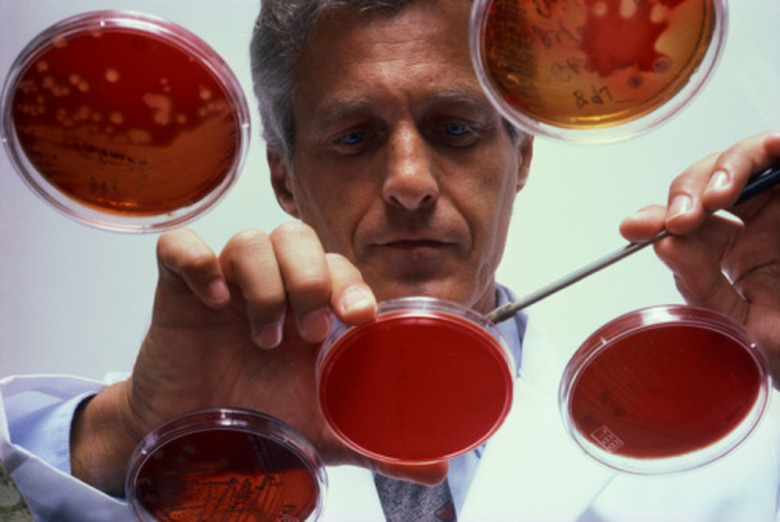Pathogenic Bacteria In Soil
Pathogens are microbes that cause disease in their hosts. While plants usually have more to fear from soilborne pathogenic fungi than from soilborne bacterial diseases, a variety of pathogenic bacteria that live in soil cause disease in plants as well. There are simply too many species of soil plant pathogens to list them all, but the following are some of the most important or common species or groups of bacteria. A few species of bacteria in the soil can prove dangerous or even deadly to humans as well.
Clostridium botulinum
Clostridium botulinum
C. botulinum is a gram-positive bacterium (i.e. a bacterium that tests positive on the Gram staining test) that forms hardy, durable spores. When the spores find the right conditions, they germinate and begin to grow. They can produce a lethal protein called botulinum toxin, which acts on the nervous system in humans and other mammals to block the release of a key neurotransmitter called acetylcholine.
C. botulinum spores are found in soil and water in many regions around the world. They are anaerobic, which means that they only grow in the absence of oxygen. Acidic soil conditions inhibit the growth of this bacteria.
However, despite its potential dangers this bacteria also has its benefits to mankind as well. Although C. botulinum sometimes causes fatal cases of a food-borne illness called botulism, the powerful toxin produced by the bacterium has also become useful for paralyzing muscle tissue in humans as part of various medical or cosmetic procedures. When used as a therapeutic agent, botulinum toxin is known by its trade name, Botox.
Erwinia carotovora
Erwinia carotovora
E. carotovora is a highly destructive pathogen that causes disease in a wide range of plants, including potatoes and most other fleshy vegetables. This gram-negative, rod-shaped bacterium can invade the crops in the field or while in storage. This makes this species particularly detrimental to farmers, as it can spread throughout stored vegetables and destroy an entire crop yield.
The subspecies E. carotovora carotovora survives well in soil and surface waters; it can grow in the root zones of many other nonhost crops or even weed species, invading potatoes or other vulnerable crops when opportunity offers. Common potato diseases caused by E. carotovora include blackleg, aerial stem rot and tuber soft rot.
Streptomyces scabies
Streptomyces scabies
This species of bacteria is yet another with detrimental impacts on farmers. Streptomyces scabies are gram-positive bacteria that together with two other Streptomyces species (S. acidiscabies and S. turgidiscabies) can infect potatoes and other root crops like beets, radishes, turnips, carrots and parsnips.
It's unusual in that as it grows, the cells form filaments similar to those formed by fungi — albeit far smaller. Filaments of S. scabies can then break off to form spores. The bacteria spread by invading young, fresh tissues and by gaining entry to older tissue by way of wounds or natural openings.
Xanthomonas Species
Xanthomonas Species
Xanthomonas is a genus that includes many important and damaging plant pathogens. Unlike some other pathogenic bacteria, most members of this species do not remain dormant in the soil for long periods. Although most do not persist for very long in the soil, some species can survive in the soil over the winter and infect a new crop in the spring.
Like all other proteobacteria, they are gram-negative. The species X. campestris causes black rot in a wide variety of plants and is perhaps the most economically important, albeit detrimental, member of the genus. Like many other bacteria species, X. campestris still has some economic importance to humans despite its detriment to farming. Ironically, the same bacterium is grown commercially to produce xanthan gum, a common food additive.
Cite This Article
MLA
Brennan, John. "Pathogenic Bacteria In Soil" sciencing.com, https://www.sciencing.com/pathogenic-bacteria-in-soil-12525782/. 1 December 2021.
APA
Brennan, John. (2021, December 1). Pathogenic Bacteria In Soil. sciencing.com. Retrieved from https://www.sciencing.com/pathogenic-bacteria-in-soil-12525782/
Chicago
Brennan, John. Pathogenic Bacteria In Soil last modified March 24, 2022. https://www.sciencing.com/pathogenic-bacteria-in-soil-12525782/
